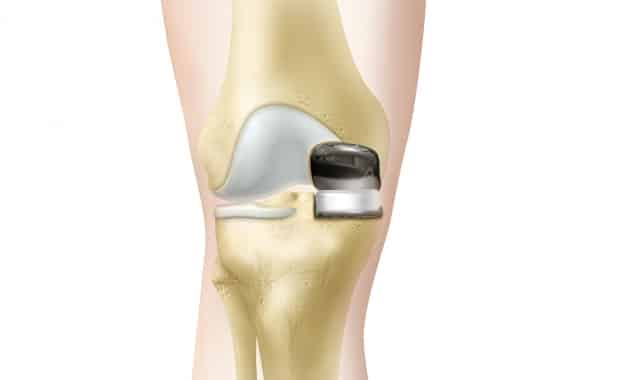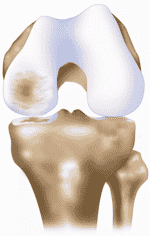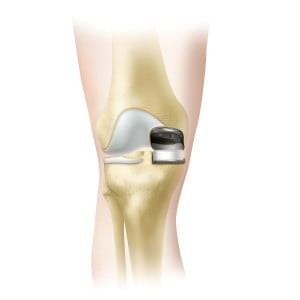
Knee Resurfacing (also known as Partial Knee Resurfacing, Partial Knee Replacement (PKR)) retains the healthy compartments of your knee joint and only replaces the damaged surfaces. Resurfacing may be an option for you if the arthritic deterioration of your knee is limited to only one or two of the compartments of your knee.
Are you a candidate for Partial Knee Replacement?
Even though most knee replacement candidates need a total knee replacement, there is a small percentage of patients who qualify for resurfacing / partial knee replacement. In order to be considered, the osteoarthritis deterioration must usually be limited to one or two compartments of your knee. Your chosen orthopedic surgeon will discuss your options with you, including whether a PKR is a viable option and advisable in your particular circumstance.

Unicompartmental Osteoarthritis (image credit: ConforMIS)
Arthritis of the knee may occur in any one, or all three compartments that make up your knee joint. The inner or medial compartment of the knee and the outer or lateral compartment of the knee are formed where the thighbone (femur) and the shinbone (the tibia) meet. The third compartment of the knee is formed where the kneecap (patella) and the front part of the femur meet. This is referred to as the patellofemoral joint.
The medial compartment is the most frequent site affected by osteoarthritis of the knee, with the disease occurring less frequently in the lateral compartment. Arthritis that is confined only to the patellofemoral compartment of the knee is rare.1
If your anterior cruciate ligament (ACL) is intact and you have relatively good alignment of your joints, a total knee replacement may be avoided or at least delayed by resurfacing only the damaged weight-bearing surfaces.2
Partial Knee Replacement Surgery
During a PKR procedure (also called Unicondylar (UNI) in trade lingo), if your bone disease is limited to the medial compartment, your surgeon may simply reshape those damaged surfaces. The repaired surfaces on that side would then be partially covered with a combination of metal and plastic bearings, and resurfaced with a cobalt chrome implant that conforms precisely to the anatomy of the knee. The tibial component would be made of polyethylene and only require minimal bone removal to secure the implant. All healthy cartilage, ligament and bone in your knee would be retained (so the other compartments must have healthy cartilage for this procedure to be successful).
A partial knee replacement implant is much smaller than a total knee replacement implant and does not disturb the healthy tissues of your knee. By selectively targeting the portion of the knee that has become damaged by osteoarthritis, your surgeon can isolate and resurface only the arthritic portion of your knee without compromising the healthy bone and tissue surrounding it. By retaining undamaged parts of the knee, your joint may bend better and function more naturally.
Partial knee replacement implants, being so much smaller than total knee replacement implants, can be placed through quite small incisions, sometimes as small as 3-4”. Some surgeons use a surgeon-interactive robotic arm system, which allows your surgeon to pre-operatively determine the damaged area of the bone to be removed and to plan the precise alignment and placement of the resurfacing implant specific to your anatomy.
For skin closure, a subcuticular suture is inserted just beneath the skin, or skin glue is used. Though only a portion of your knee joint is affected and the basic structure of the knee remains intact, pain experienced during recovery is generally about the same as with a total knee replacement although some patients may have a better experience.
Partial Knee Replacement Implants

Oxford Partial Knee (image credit: Zimmer Biomet)
For partial knee replacements there are partial knee implants designed to replace any one arthritic compartment of the knee (known as “unicompartmental” knee systems).
Each compartment of your knee can be individually affected by arthritis and there is an implant specially designed for each. If a second compartment then becomes diseased, that too can be fitted with the appropriate unicondylar implant and after that, even a third implant may be fitted. In this way a total knee replacement can be achieved but with limited removal of bone and ligaments.
Unicompartmental Partial Knee Replacement
If only a single compartment is to be replaced, your surgeon will use a unicondylar (UNI) fixed bearing knee implant, the most commonly used prosthesis, or a unicondylar mobile bearing knee implant.2 The advantage of these types of implants are such that only the arthritic portion of your knee to be covered by the implant needs to be removed. Your surgeon will determine which implant design and knee implant materials are best suited for your knee.
Bicompartmental / Tricompartmental Partial Knee Replacement
If osteoarthritis has progressed to more than one compartment of your knee, a total knee replacement has traditionally been the only treatment option available. Now, surgeons have the ability to remove two (bicompartmental) or even three (tricompartmental) components of your knee joint and replace them with partial knee implants.
The advantage of a bicompartmental rather than a total knee replacement is less damage to healthy ligaments during the procedure, and the likelihood that your repaired knee will function and feel more like your natural knee.3
More about Partial Knee Replacement Implants >>
Longevity of Partial Knee Replacements
Generally, knee resurfacing patients can expect to use their partial knee replacement for 10-12 years, depending upon age, weight, and activity level. Many orthopedic surgeons around the world report a success rate of about 92% at 10 years, indicating that many patients have long-term enjoyment of their partial knee replacement.4
Complications after surgery
The risks associated with partial knee replacement (resurfacing) are quite low. Blood clots are the most common complication after surgery, and usually avoided by the use of blood thinners and wearing support (compression) hose. Additionally, your doctor may prescribe antibiotics to help prevent infection after the procedure. Other possible complications include implant loosening, fractures, and nerve or blood vessel damage.5
Advantages of Partial Knee Replacement
In appropriate cases, the advantages of partial knee replacement over total knee replacement include a smaller scar, marginally quicker recovery, marginally less post-op pain, and less blood loss. Some recipients maintain that a partial knee replacement feels more natural and provides better range-of-motion.
Disadvantages of Partial Knee Replacement
The main disadvantage of a unicompartmental or bicompartmental partial knee replacement is the potential need for more surgery in the future. If osteoarthritis progresses to the other compartments of your knee, a total knee replacement “revision surgery” may be necessary.
Knee Revision Surgery
After you’ve had your partial knee replacement for some time, if the degeneration of the remaining healthy compartments of your knee has adversely affected your quality of life (most often due to osteoarthritis causing damage to what was once healthy bone in your knee), your surgeon may recommend conversion to a total knee replacement, known as a revision.
However, because of the benefits of unicompartmental and bicompartmental implants (specifically retention of a greater amount of healthy natural components of your knee, more natural knee function and feel), research indicates a bias toward partial knee replacement if your surgeon determines you are a candidate for such a procedure.6
Patients of all ages have achieved excellent medium- and long-term results with partial knee replacements. Each patient’s anatomy is different and each surgical intervention must be customized to the particular patient’s needs, as well as the specific surgeon’s expertise and familiarity with implants from the various manufacturers. Use the information here to help you intelligently discuss your options with your surgeon and to better understand his or her recommendations for your treatment.
More about knee revision surgery >>
image credit: Zimmer Biomet
Sources
- The Hospital for Special Surgery, Alexiades, Michael M. M.D., Boettner, Friedrich, M.D., Pearle, Andrew D. M.D., “Partial Knee Replacement: A Treatment Option in Unicompartmental Knee Arthritis” http://www.hss.edu/conditions_partial-knee-replacement.asp
- Wake Forest Baptist Health, “Robotic Partial Knee Replacement” http://www.wakehealth.edu/knee/
- Zanasi, Stefano “Innovations in total knee replacement: new trends in operative treatment and changes in peri-operative management” http://www.ncbi.nlm.nih.gov/pmc/articles/PMC3150806/
- The Florida Knee and Orthopedic Centers, “Avoid Total Knee Replacement with a Partial Knee Replacement (Resurfacing)” http://fla-ortho.com/services/your-knees/partial-knee-replacement/
- American Association of Orthopedic Surgeons, “Unicompartmental Knee Replacement” http://orthoinfo.aaos.org/topic.cfm?topic=A00585
- Parratte, Sebastien, M.D., Pauly, Vanessa, M.S., Aubaniac, Jean-Manuel, M.D., and Argenson, Jean-Noel A., M.D. “Survival of Bicompartmental Knee Arthroplasty at 5 to 23 Years” http://www.ncbi.nlm.nih.gov/pmc/articles/PMC2795810/
Filed Under: Knee ReplacementKnee Replacement, Resurfacing, Revision




